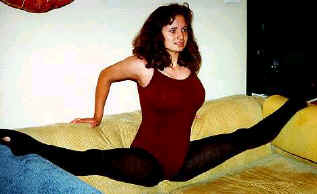
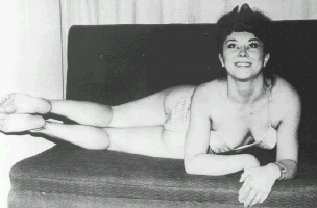
The Contortionist's handbook
Introduction
Ever wondered how those incredible contortionists and acrobats you've seen on TV or at the circus can do their fantastic poses or how yogis can move their bodies in a way that you never thought was possible and how they feel? Ever wanted to be able to do it yourself? Here's the chance. It might take "time, blood, sweat and tears", but you will get there with the exercises you'll find here if you just give it some time every day.
The exercises used in contortion (and yoga as well) is used by various circus artists, dancers, gymnasts and many others. It is a wonderful feeling to be able to move the body without any limitations and the goal with this page is to show you how to do it and most important: how to get there. Having practiced myself as well as trained others me and my co-authors have noticed that much of this is kept almost like a trade secret and believe it shouldn't be. An other reason is that there are many "schools", more or less experimental, that also should be mentioned as they can have the effect that you search for, but can't find. There can also be the situation where you don't have a coach or school in your area. In the process of writing and publishing previous versions of this handbook me and my co-authors have received numerous of mails from all parts of the world. We want to share that experience as well as it might be of use for you in your training. So one of the most important reasons that this handbook is published is simply: we don't want the knowledge to be lost. It should be available everywhere.
To tell the truth
exercising to improve your strength and flexibility the way contortionists, dancers, gymnasts and many others do isn't as difficult as it seems - nor is it dangerous (as some may believe when they see it). A common question is if it hurts and for example, if a dislocation of a joint hurts or has permanent side effects. The answer to that is simple: it doesn't hurt and there are no negative permanent side effects. It is uncomfortable in the beginning, but you feel the discomfort lesser for each time you do the exercises and sometimes even each time you repeat an exercise while you carry out the schedule. The more you exercise the more pleasant it feels. Any position you will see feels natural and will feel the same to you if you follow the instructions and give it some time. Just to give an example I can tell you how it feels to dislocate the shoulder in a proper way when you are used to it. First you feel something like a crack or click and then you can feel the joint slide out of the socket. The feeling is amazing, because everything happens inside you and it's like a tickling sensation. It doesn't hurt for a second. Instead it feels like the bones inside were swimming around in a mass of gelly. That is probably the best description. Does it sound terrible? I hope it doesn't, because it isn't. Practice will give you exactly that feeling, a body that is able to move in any way you wish, a great portion of satisfaction and as a bonus you'll stay healthy. So as you can understand this can be a natural way of living and I hope it will be for you too. A backbend (or even backfold) that might look impossible or even freaky to you will in time feel like any natural move and be very enjoyable to do. Just observe any member of the animal kingdom. Every animal exercises every day and they instinctively know that the secret of a long and healthy life is a flexible spine. Any part of the body that is not continually used will eventually cease to function. Most people don't stretch, do yoga or contort and maybe there's the key to why many have trouble with their spines and other health issues connected to bad posture and an unhealthy and poorly trained spine. Anyone, including you, can become good if you only take your time and believe that you will get there one day, because it's much about believing and giving it time. For some it will take no time at all, but some will have to struggle a little bit, maybe because you've lost some of your flexibility because of age. Something that is recommended is to stretch daily for around a month before you start doing these exercises. Easier yoga asanas like the sun greeting are recommend warmly since it will give you the basic flexibility and strenght needed to do the exercises without struggling too much, but normal stretching is enough. Also it's worth mentioning that yoga is very similar to contortion.There are many benefits with doing contortion. Some of the most important are
Anyone that is serious, willing to put enough time and has patience. Some say that any over the age of 25 years shouldn't start contorting. Others refuse to train men, because they considered as good as women (or maybe the coach doesn't like to train men due to other issues not needed to be mentioned here?). Let's kill those myths. There are men that are 55 years old and can do many of the poses and exercises on these pages and the only difference between a man starting in the middle age and for example a 20 year old woman that has started in her childhood is that it takes him longer time to be successful with the same things she is in short time.
What types of contortionists are there?
Either a contortionist is are a "frontbender" or a "backbender" and all the facets of the act are built on these movements and the ability to hyperextend or hyperflex the spine. The frontbender is many times the "funny man" as he can take up ludicrous positions and perform amusing feats like placing the feet around the neck while standing on one hand. This doesn't mean that men can't be good backbenders. There are men that can do better backbends than any woman and to know whether you're one of them the only way to find out is to do the exercises and in time see. In contrast to the frontbender the backbender or "posturer" has a more serious act. It's often a woman, but as I said it doesn't have to be like that. The backbender performs speciality acts or incorporates the abilities into a graceful dance routine.
To get back to the question who can do this the answer is, as you can see, anyone. What makes the difference is that to be good you have to practice daily and the more the better. One day of inactivity will result in a marked stiffening of the joints. However this is something that happens in any type of activity. Practicing is the key to being good
(and avoiding cigarettes, alcohol and other poisons).
So why not begin? You don't know what you've been missing.
How much practice do I need?
First of all let me point out that this is VERY individual and also depends on what goals you set. A contortionist can practice for around three hours daily or even more. Don't get scared of this. You decide the amount of training and who said that you want to be a contortionist? Even if you want to practice for three hours it can be one hour in the morning, one during the day and one in the evening before going to bed. As you can see a good way can be to divide up the exercising so that you do them during the day, for example a set of exercises in the morning, while having lunch, after getting home and before going to bed ans different exercises in the different blocks. The alternative with dividing up the practicing will help you to keep the maximum possible suppleness.You'll soon find out that you can do many of the exercises while doing something else like...


...when watching TV, reading a book...
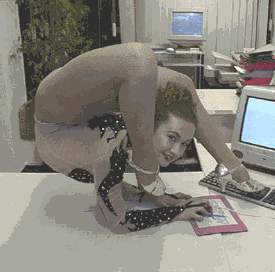
...or even chatting on the internet and that you'll be comfortable and enjoy doing it at all times. As with everything the more you do it the better and then why not combining it with other things you have to do? It will definately make the practicing much more interesting, so don't be afraid of having fun. If you have done all the exercises and feel that you have more time then try to do them over again. You will be amazed over how much easier it will be. Repeats are the secret to become and stay real supple. You also build strenght in the muscles this way.
But again, as I said before, your set goals also have a lot to say and it can be well enough with an hour daily to increase the overall flexibility, even if it won't make you a contortionist. Most likely you'll end up practicing for more, because you'll enjoy it very much. However it's important to point out that you should do the exercises daily if you want any results, even if you only do that hour each day (and around one hour is what you should begin with).
Remember that loosing one day of exercising means that it can take up to one week to reach the same level of flexibility. The same is if you miss out a weeks exercises. It can take a month to reach the same level. So if you can't set aside some time each day to exercise don't start practicing at all (and miss the best experience of your life)!
Some about food
Someone once said that eating is believing and it maybe sounds silly, but it's the truth. There are as many recommendations on what to eat as ways to train. Some say become a vegetarian, but I don't agree.
You can continue to eat meat, but not as much as before and
avoid fat as much as possible. That means continue eating what you ate before, but in normal proportions
and with a little bit more awareness of what you eat. Listen to your body and most important of all eat healthy. If your body asks for fruits, eat fruits and so on. You'll also soon find out that you'll quite automaticly change your habits.
Something I recommend is to eat fruits, hazelnuts and a cup of tea for breakfast. For lunch eggs and some fruits and to dinner always something cooked like meat or fish, root-crops/- fruits and some fruits. You can use all kinds of spices, but try to avoid salt as much as possible (this will be difficult in the beginning, but after some time you won't want salt to any kind of food, because it will taste awful). Except for that eat berries, sea food and honey. Also try
not to eat for 1-2 hours before you exercise. Doing a backbend or a frontbend with a full stomach isn't recommended
and can result in you throwing up. Also try not to drink alcohol and absolutely never smoke. If you start to train and drink alcohole (even if not a big amount) or smoke just one cigarette you will feel that your training will feel more difficult and you'll maybe not have the same range of movement the next day.
The result of this will be that you'll loose weight to what was your teenager average weight, the blood preasure will get lower and the same with the colesterole. You will feel much better, think much better and it's much easier to practice.
The eating habits above remind much of what different yoga books recommend and contortion
is very similar to yoga. The same food was also eaten by people in the
stone age as well as today by the people on the island of Kitava where the living conditions are similar to the ones in the stone age. Many times the people there are very strong, flexible and
your average day heart disease doesn't exist there. The difference to what I
mentioned above, except for the alcohol, is that they also avoid sugar, milk or cheese.
However in the end you decide what to eat and drink and these were only some healthy thoughts and recommendations to help you on the way. One thing is important
though: DON'T EAT MORE THAN NOW AND NOT TOO MUCH!!!! The exercises will make you hungry, but that doesn't mean you need to eat more.
Clothing and enviroment
There are many different clothes to wear while practicing, but the rule (depending on where you are) is the less the better. To wear loose fitting attire is often recommended, but unitards or catsuits are much better and work very well both for men and women. Most dancers, contortionists and gymnasts wear them and they give many benefits compared to other clothes when fitted perfectly to your body.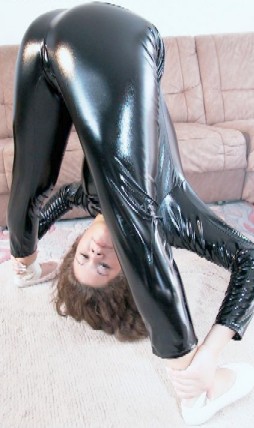
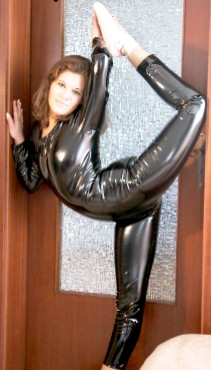
Jazz pants and a top, shorts, bikinis and similar, can also be good, but they need to be tight fitting and if you use such attire the place where you exercise MUST be well heated! Again it's important that your clothes don't disturb you in the exercises or restrict your movement in any way.
As this handbook isn't writtein for new beginners only, but also for professionals, it's worth pointing out that your clothes also give a great impression and can lift the act to a different level while performing. Many times catsuits with metal or wet looks can be the excellent choi
ce as they don't restrict the movement, but also help the audience to see you better if the lightning is poor or you want to use various kinds of effects. Also they are cheap. In a circus tent or out in the open it can be worth not to forget that you need to be warm. It's better to be warm and sweat than freeze and risk injury due to that the well-effects of the warm up wear off.When it comes to footwear you should also invest in pointe shoes or other shoes as pointing your feet as many exercises are more effective when done en pointe. Many dancers, gymnasts and professionals heartily recommend those made by Capezio. You'll find more information about it in the other leg exercises page. There has been quite many mails from ballet dancers recommending prolonged daily wear of ballet boots while not dancing or exercising in order to train balance, the feet's flexibility and strength and to be able to stay en pointe for as long as needed. It may be true. See more about that in the ballet boots page. However, if you're to wear this type of apparel on a daily basis always remember to stretch the feet, to do the pointť exercises, among those the ballet positions. This has to be done daily in order to allow the feet to keep their strength and flexibility. Otherwise prolonged wear (more than 5-6 hours a day) may damage your feet.
Something that also has been mentioned in e-mails from Germany, The Netherlands and, to my surprise, Russia are the positive effects of combining contortion and rather extreme tight-lacing / corsetry. I have received descriptions, pictures and videos from professionals using this method, lacing their waist as much as 25 cm 24-7, except for toilet needs, exercising and performance. The exercises they do are the advanced ones from the schedule and according
to what I can see the contortion training makes it easier for them to tight-lace rather extremely as well as the tight-lacing helps them to get more limber faster and most have been able to fold their backs a little bit over a year after beginning! One of the reasons can be that the corset simulates the effect to the body of a deep backbend or a backfold where the organs are very much compressed and displaced and the ability to breathe deeply is reduced. The corset wearer's bodies has adapted to this due to the constriction and therefore the positions involving backbends are much easier to do than normally. As some corsets, so called pipe-stems, lengthen the spine, this also makes it easier to bend it in all directions. I haven't seen any documentation on this before, so I keep this open for discussion.Also the enviroment in the room can be important. Never have a cool temperature in the room (less than 18įC) while exercising. It's obvious since it's very important to keep the well effects of the warmup while exercising. Of course it's easier to breathe and not to need to sweat while doing exercises in a cold room, but you risk injuring yourself as the well-effects of the warm up wear off very quickly. Again I would like to point out that you always should remember to be warmed up before performing and if your performance is to last longer periods always be properly clothed.
How to follow the exercise schedule
Initially before stretching out there are
some things you should do if you want to get good results from the exercises and most important of all, don't want to
injure yourself.
ALWAYS DO WARM UP BEFORE YOU START TO DO SOME SERIOUS STRETCHING!
This is very important, no matter whether you can sit on your shoulders, do the best oversplits in the world or are a new beginner. A good warm up can be any activity that will make your blood circulate like running around a little bit, maybe in stairs and then first doing the exercises lightly stretching to where you can get without feeling that the muscles get tense.
This means no real stretching, but during several repeats you go to the the most flexible position where you feel comfortable, but not further! Many recommend doing the yoga sun greeting rapidly repeatedly until you are warm. The warmups promote circulation, respiration and general loosening of joint bindings.Any athlete, dancer, gymnast or contortionist injure themselves if they don't warm up - NO MATTER HOW GOOD THEY ARE!
Without warming up you will most likely get hurt!
Another thing worth to remember is that many things that you do during the day can be done in a flexible way. Why not bend forward with legs straight when you're going to tie your shoe laces or maybe chat, read books or watch TV while in a split, oversplit or backbend, backfold when you get there. You will feel very healthy of this and at the same time you will prevent any loss of flexibility during the day. This will also make you more ready for the more serious exercises. However don't forget to stay warmed up. If you're not flexible at all before you begin using these exercises I would recommend to do some easy stretching exercises or easier yoga asanas for a month. Some basic flexibility won't hurt and it will be much easier to do even the easiest exercise.
If you aren't strong in your back you will also need to to strenghten it, so you can return to an upright position after a backbend. One way is to lie on your back on the top of a gym horse, couch or bed with someone sitting on your lower legs, with your upper body overhanging the edge and bending back down and then up again. Another way is to lie across two soft chairs supported by your shoulders and hips and flex your back. Both these exercises will need someone to assist you initially.
Post warm up
After warming up you're ready to do some serious stretching. The exercises are built up like a very easy looking program where the level increases with the number of the exercises. Do all exercises till you reach the most advanced exercises you can do for each group of muscles. You will feel which exercises that correspond to which muscle group. If you want to do all the exercises this will take approx 3 hours. As you advance you can skip some of the easier preparing exercises, but always ask us, or if you have one, your coach. Instead such exercises can be used as a part of your warm up. If you are a newbie don't do more advanced exercises than you can handle. Do the exercises you are good at and those that are difficult, but that you still can manage to some extent. They are supposed to be a challenge and will help you improve. That's the way you get results. On the other hand if you go to fast and do exercises that are far too difficult for you to handle you might end up injuring yourself.
The exercises are set so that the easiest come first and then the level of advancement increases the further you go. Always begin from the first exercise and work towards the more advanced. When you've succeeded with the exercise you're doing then move along to the next exercise. Continuing like that in time you will be able to do all of them and then it's good to do as many of them as possible. After each session write down which exercises you've done in a notebook. This way you'll know what you've done the day before, but you'll also be able to see how you're advancing.
The way to see whether you shouldn't do an exercise is that it's too difficult to do. Then
don't do it - yet, but do do it when you're ready for it! Yes, I'm repeating myself, but this is very important and I don't want you to injure yourself! The pictures are to show how the exercises are to be done, but also to show how it will look when maximum flexibility in the exercise is reached. Donít worry if you canít do them as good as the persons in the pictures. Instead use the most advanced pictures to set your goal. You will get there sooner than you think.Do not jerky actions. Try to stretch out as much as you can without getting hurt or being uncomfortable. Donít forget that with the exercises you are to achieve the maximum flexibility by stretching out as much as possible so donít give up! You will get further sooner than you expect. The 1-2-3-4-5 is a progressive stretch a little bit at each count, then stay there counting 1-2-3-4-5 or if you're comfortable until you feel the muscle being strained. Then release only a few degrees to a resting position where it feels more comfortable or if instructed to an initial position and continue the stretch from where you were at the count of 5 the last time, but trying to get a bit further while counting 1-2-3-4-5. In the last repeat try to stay as long as possible in the position. Each repeat is a count of 1-2-3-4-5.
If you are lucky enough to have an
assistant to stretch you (of course always after warming up)
relax while your
assistant stretches you out until it's not possible to go further.
Do not try to counteract. Unless
otherwise instructed do the assisted stretches the same way as if you were
without an assistant, with the difference that the assistant will hold you
longer in the finishing position at the count of 5. In the beginning when doing
an exercise, assisted or not, or if you have been able to stretch further than
you've been able to do before it can hurt while in the position. This is normal and will only last for around a week
or two. Then you can continue further and after you reached your maximum flexibility you wonít feel any pain at all when you stretch out and you will be able to stay in any position for as long as you want without any discomfort.
Don't "overdo" any exercise
until you feel that you are in a so advanced level
that you can master it perfectly and see or feel that you've achieved what is shown on the pictures.
Let your own body set the limits and instead of overdoing
do many repeats. Repeats are the key! 10-25 repeats are usually
the best depending on your age, gender, flexibility etc. The number of repeats in this case is a recommendation. If it should be carried out 20 times and you carry it out 40 times, it doesn't mean that you will get twice the flexibility and if you carry it out 60 times you may find that your muscles are stiffening up again. Try to keep the repeats on a level that feels good.
The amount of repeats are only a recommendation. You'll find very quickly which amount of repeats is the best for
you, but don't do less than 10 repeats.
Remember that if you're impatient and force your body you will only strain something and have to wait until you
heal, before you can start again.
The only situation where "overstretching"
is allowed is when doing assisted stretches since you're to be completely relaxed and
the assistant is doing the stretching for you!
Always follow the instructions carefully and religiously and never give up. In time you will be able to do the exercise. Not all are able to do all the exercises at once and the difference in how long it takes for succeeding in an exercise or position is different for everyone. It can take days for some while other need months. Some quickly gets flexible in their back and at the same time hits the wall when it comes to the splits. Others manage the splits, but has difficulties with doing backbends. Don't let that stop you. Do more exercises in the tough part of the body instead. It will give results in the longer run. This difference is also often noticed between men and women so donít give up. Take your time and you'll won't hurt yourself. Everyone is able to do this if they exercise properly and do each exercise until it feels comfortable. Have patience.
If you have time feel free to repeat the schedule (I think you will very soon). That is one of the keys to success. You should notice an increase in your flexibility and strength towards the end of your exercise period.
After doing the stretching exercises it can be good to do the stretches, but only with one repeat, the same way as you did in the warm up. This way you can convince yourself and, most important, your mind what your real flexibility is and this will help you the next time when you stretch out. Those five minutes doing this are as important as the whole exercise. What the brain believes and what's really happening are two different things.
Also it's good to have someone watching you while you exercise, not only to make certain you carry them out correctly, but to ensure your backbends are carried out by the whole spine and not just between two vertebrae. Particular care should be taken in the area of the lower back. Finally when you do backbend exercises always
do frontbend exercises afterwards. If you can't have someone watching you while you exercise see if you can record it on video. That way you can check your progress as well as correct any errors, but show us if necessary.
Assisted stretching
If you have difficulty getting into the position or to keep the stretch you always should have someone to assist you. It's the best way to get the best results and most athletes, dancers, gymnasts and other professionals have their coaches to assist them in their stretching. One of the assistants most important functions is to keep you in the position, since otherwise you'll most likely go out of the position or stretch far to early. The assistant should push you firmly and if you're advanced very firmly into the position and then hold you in it for at least 30 seconds, then release so that thereís no stretch for a short time, again repeating giving it a little bit more stretch than the last time as many times as mentioned in the exercise schedule or more until the muscles can't be stretched more. For each repeat the time the assistant holds you should increase with a few seconds seconds. You must stay completely relaxed at all times. The second most important function of the assistant is to see that you don't get out of the position. In the beginning t
his method can be quite uncomfortable and even very painful depending on your pain treshold, but no pain gain. The secret is not to give up and you'll soon find that you prefer to be assisted than stretching by yourself. Assisted stretches always give far better results than if you try to do it yourself, but this is of course your and the coaches prerogative to choose which method to use. As force is included the trust towards the assistant is of greatest importance.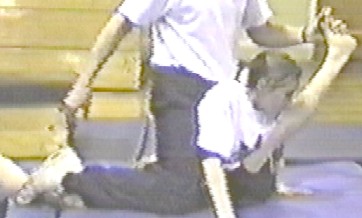
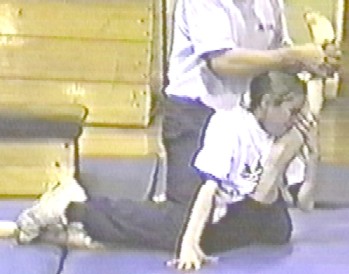
The pictures above are of a contortion student being stretched into a 270 degree oversplit. All repeats were carried out (with a resting around 10 degrees less from the last repeats) on both legs from sitting in a regular split to the 270 degrees oversplit. As you can see her first attempts weren't comfortable as you can see, but today she can sit comfortably in a oversplit for longer periods having the rear leg horizontally on the floor and the front leg vertically on the wall and then change doing the same with the other legs without standing up! It took her two months doing this daily to achieve this position and six more to be able to sit in the position for as much as one hour comfortably.
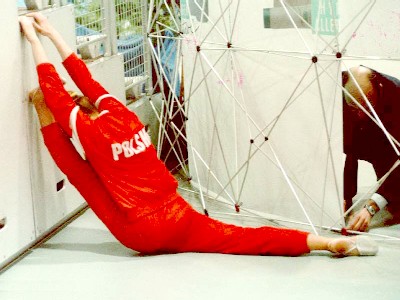
An other example is this rhythmic gymnast. Her oversplits are amazing, up to 300 degrees, and she can apparently, according to her coach, stay in them without any time limits at all. The secret is that she has been assisted in her stretches on a daily basis from the very first beginning, when she started doing gymnastics.
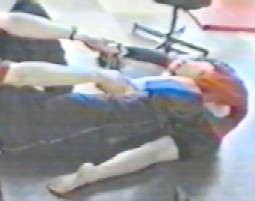
An other example is Helena. She only uses assisted stretches and you can judge from the result yourself. The picture to the right is her backbend which she reached after over one year. Normally it takes at least the double amount of time to accomplish a backfold like this no matter what age you are and then you normally won't get that good without being assisted.
As I mentioned before assisted stretches are very uncomfortable in the beginning, but your pain treshold and especially your endurance will improve much faster than you think and this makes it much easier than you think from seeing the picture above. The assistant is helping you with what you normally wouldn't stand - holding you in a position you wouldn't stand, because of lack of endurance or of too much initial pain or discomfort. This, however, changes very rapidly to helping you reaching a certain position that you wouldn't be able to reach without any help even if you're comfortable doing it. The explanation is simple. For most the initial reaching of a certain level of flexibility assisted is most uncomfortable or even unbearable the first two weeks to the first two months depending on how far you go and depending on how flexible you are in the beginning, but it gets less and less uncomfortable the longer time you practice and after that amount of time you should feel comfortable in the position and instead work on staying as longer and longer in the position and getting deeper and deeper into it and still feeling comfortable. That's also the reason why most professionals like acrobats, dancers, contortionists and gymnasts prefer assisted stretches. You always should have a 20% flexibility reserve when you're to perform in order to always being comfortable while working. Every professional knows this. Also assisted stretching is the most efficient way to extreme flexibility and it goes much faster than any other mean of stretching (professionals know that too) and most important - you can stay relaxed during all of the stretch and then it also gets comfortable! Also your pain treshold will change the more you do assisted stretches making it possible for you to advance much more and faster than in the beginning. If you train together with a partner of a different gender, and you wish to be at the same lever at all times do assisted stretches. If it's a male partner assisted should be used. In this case hold the stretches longer and to the same level as the female partner.
Persons with hypermobility, hence with natural flexibility, should do assisted stretches as much as possible. This decreases the symptoms of hypermobility. If assisted stretches are done as described they are a very good and effective alternative for achieving supplenes much faster. Every exercise can be done assisted and in most you'll find notes suggesting how this can be done, but don't be afraid to experiment. It's not dangerous if you and your assistant know your limits and you trust eachother. Also feel free to ask us.
You will get there sooner than you think.
Important notice 1!
Always do a frontbend after doing a backbend, even if only once. The more advanced backbend is the more advanced frontbend should be. They should correspond to eachother. This is for balance in the back, but also strenghtens and lengthens the spine and the muscles around it. It's also important to do all the other types of exercises. They all correspond to eachother and will help you to get better allover.
Important notice 2!
If you have suffered from one or many dislocations in either hips or shoulders you should learn to do controlled dislocations as well as use assisted stretching as you mainly used method when doing the exercises here. This often is a symptom of hypermobility and you will sooner or later dislocate again. This is often missed by MD's unless this is mentioned. One reason could be that around 40% of the population are hypermobile and often without knowing it. The symptoms can often be pain in joints, hypermobility and dislocations of the joints (for example if you can learn how to do a split in a short time, partially dislocate your shoulders - that often means that you will hear a popping or cracking sound - or if you have overbent elbows you most likely are hypermobile). Very often the symptoms show gradually, often with pain or dislocations, and sometimes increase with time to states that aren't controllable. It's not a question if it happens, but when. To prevent this itís important to learn to do controlled dislocations, build up strenght and flexibility around all joints and practicing contortion does all this. The reason is simple. If a symptom like a dislocation occurs and it isnít controlled your muscles will go into spasm. Being able to do a controlled dislocation prevents this and it should be done many times on a daily basis. A controlled dislocation is a dislocation where you are able to dislocate the joint, move the limb with the help of another limb or with help from someone that assists you and then putting it back to it's normal state. All joints that can be dislocated should be trained in this order of fashion and the controlled dislocation must become a part of your normal range of movement! It's important to train all joints that dislocate, because that you once had an uncontrolled dislocation in i.e. the hips doesn't mean that the next won't be in the shoulders etc and the dislocations gradually worsens for each time making it impossible to control them in the end. You should work the same way with backbends and later backfolds since the dislocations can spread to other areas than the joints around the limbs. When working on backbends and especially backfolds put a stick, a finger or something appropriate to increase the fold and partially dislocate the vertebrae. The last part is very important! Using the contortion barre is recommended. Persons that have experienced or experiences symptoms like dislocating, pain in joint and hypermobility should work towards being able to do all of the program to perfection, as a prevention, to be able to get the joints and the muscles around the joints supple to the outer limit and learn to control them in situations like this by doing controlled dislocations as much as possible. Also all exercises, if possible, should be done assisted with firm stretches until the maximum suppleness is reached at least once each day, preferrably more! This might be difficult, uncomforable and even painful, but only in the beginning. Itís not as difficult as it sounds and that is something youíve probably found out by now or will. Do this with an open mind and enjoy yourself.
Important notice 3! There's no possibility for neither me or the co-authors to handle 300+ mails asking for help and advice - daily! Providing such a service would mean a full time occupation. Therefore the email addresses have been removed from this site. A limited number of students can be admitted and receive online help, advice and coaching for Ä200 per semester or Ä400 / year. For any inquiries feel free to write to [email protected].
Links to all the pages
Schedule construction
Newbeginners schedule
If you can or have time try to do more exercises in the same order. If possible always have someone to assist you in the stretches. If you can make as many exercises using the contortion barre as possible.
Semi advanced level schedule
If you can or have time try to do more exercises in the same order. If possible always have someone to assist you in the stretches. If you can make as many exercises using the contortion barre as possible.
Advanced level schedule
All advanced exercises should be done with perfection without anyone assisting you! In the last exercise have someone to assist you to get "beyond" the position and to increase the amount of time you can stay in the position. The same using the contortion barre.
GOOD LUCK!